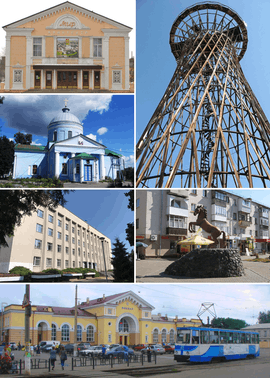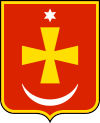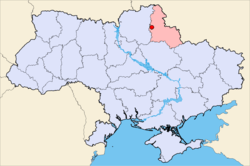Konotop
Konotop (/ˈkɒnɒtɒp, ˌkɒnɒˈtoʊp/; Ukrainian: Конотоп [konoˈtɔp] (![]()
Konotop Конотоп | |
|---|---|
City | |
 Counterclockwise (from upper right): Shukhov Tower, Myr Cinema, Ascension Cathedral, Konotop City Council Building, Monument of Horse, Konotop railway station and tram | |
 Flag  Coat of arms | |
 | |
| Coordinates: 51°13′N 33°12′E | |
| Country | Ukraine |
| Oblast | Sumy |
| Founded | 1634 |
| Government | |
| • Mayor | Tetiana Syzon |
| Area | |
| • Total | 43.78 km2 (16.90 sq mi) |
| Elevation | 142 m (466 ft) |
| Population (2015) | |
| • Total | 87,881 |
| Website | Official website |
History
During the beginning of the 17th century, Cossacks were first based in that area. The settlement was first mentioned in 1634 in various documents as Novoselytsia. In 1642 a Polish fortress was built in that place named after the river Konotopka. Probably the river disappeared, and another one was created, Yezuch. The fortification became a key point in the struggle against the Moscow state.
In 1659 the Battle of Konotop took place near the city, in which Cossacks led by Ivan Vyhovsky (allied with Poles and Crimean Tatars) defeated Muscovite forces. In 1782 Konotop was granted municipal rights.
During World War II, Konotop was occupied by the German Army from 3 September 1941 to 6 September 1943. Details of this are recounted in the book The Forgotten Soldier by Guy Sajer
In 2015, the city elected Artem Semenikhin of the far-right Svoboda as its mayor.[2][nb 1] Semenikhin reportedly has the number "14/88" displayed on his car and has refused to display the city's official flag because it contains a star of David, and has implied that Jews were responsible for the Holodomor.[2]
Climate
| Climate data for Konotop (1981–2010, extremes 1948–present) | |||||||||||||
|---|---|---|---|---|---|---|---|---|---|---|---|---|---|
| Month | Jan | Feb | Mar | Apr | May | Jun | Jul | Aug | Sep | Oct | Nov | Dec | Year |
| Record high °C (°F) | 8.4 (47.1) |
14.0 (57.2) |
22.0 (71.6) |
29.9 (85.8) |
33.1 (91.6) |
35.8 (96.4) |
35.9 (96.6) |
39.0 (102.2) |
35.0 (95.0) |
27.2 (81.0) |
18.0 (64.4) |
12.6 (54.7) |
39.0 (102.2) |
| Average high °C (°F) | −2.3 (27.9) |
−1.7 (28.9) |
4.1 (39.4) |
13.4 (56.1) |
20.6 (69.1) |
23.6 (74.5) |
25.6 (78.1) |
24.7 (76.5) |
18.5 (65.3) |
11.4 (52.5) |
3.1 (37.6) |
−1.3 (29.7) |
11.6 (52.9) |
| Daily mean °C (°F) | −4.8 (23.4) |
−4.6 (23.7) |
0.5 (32.9) |
8.5 (47.3) |
14.9 (58.8) |
18.3 (64.9) |
20.1 (68.2) |
18.9 (66.0) |
13.2 (55.8) |
7.2 (45.0) |
0.7 (33.3) |
−3.6 (25.5) |
7.4 (45.3) |
| Average low °C (°F) | −7.3 (18.9) |
−7.4 (18.7) |
−2.8 (27.0) |
4.0 (39.2) |
9.5 (49.1) |
13.3 (55.9) |
15.0 (59.0) |
13.6 (56.5) |
8.8 (47.8) |
3.7 (38.7) |
−1.7 (28.9) |
−5.9 (21.4) |
3.6 (38.5) |
| Record low °C (°F) | −32.9 (−27.2) |
−32.2 (−26.0) |
−26.1 (−15.0) |
−12.2 (10.0) |
−3.7 (25.3) |
2.8 (37.0) |
6.1 (43.0) |
3.8 (38.8) |
−4.1 (24.6) |
−9.2 (15.4) |
−22.8 (−9.0) |
−28.9 (−20.0) |
−32.9 (−27.2) |
| Average precipitation mm (inches) | 40 (1.6) |
38 (1.5) |
33 (1.3) |
40 (1.6) |
48 (1.9) |
66 (2.6) |
78 (3.1) |
58 (2.3) |
53 (2.1) |
44 (1.7) |
41 (1.6) |
40 (1.6) |
578 (22.8) |
| Average rainy days | 8 | 8 | 8 | 12 | 13 | 15 | 14 | 11 | 14 | 13 | 13 | 10 | 139 |
| Average snowy days | 19 | 17 | 11 | 2 | 0.1 | 0 | 0 | 0 | 0.1 | 2 | 10 | 18 | 79 |
| Average relative humidity (%) | 84 | 82 | 77 | 67 | 64 | 69 | 71 | 71 | 77 | 81 | 86 | 86 | 76 |
| Source: Pogoda.ru.net[12] | |||||||||||||
Economy
The main industrial enterprises of the city include the Konotop Casting and Mechanical Plant, the Motordetal Plant, the Konotop Fittings Plant, the Konotop Car Repair Plant, the Aviakon Aircraft Repair Plant, a mechanical plant, a garment factory, a meat processing plant (Konotopmyaso OJSC), a dairy plant, and a bakery plant. Konotop is an important mechanical engineering center, food production center.
Transport
.jpg)
The city is an important transportation center. Various railroad connections from Konotop are: Moscow–Kiev, Simferopol–Minsk, Bakhmach–Kiev, Bryansk–Sumy/Belgorod. Furthermore, Konotop is one of the smallest cities in the country with its own tram system.
Gallery
- St. Nikolas wooden church
- Ascension Church
- Mansion of general Mikhail Dragomirov
 Horse statue in the downtown
Horse statue in the downtown- Old town
- Konotop Railway Hospital
- School in Konotop
- Old school in Konotop
- Konotop tram line
Notes
References
- "Чисельність наявного населення України (Actual population of Ukraine)" (PDF) (in Ukrainian). State Statistics Service of Ukraine. Retrieved 1 July 2016.
- "Local Jews in shock after Ukrainian city of Konotop elects neo-Nazi mayor".
- Likhachev, Viacheslav (September–October 2013). "Right-Wing Extremism on the Rise in Ukraine". Russian Politics and Law. 51 (5).
In their propaganda, SNPU ideologues were more open, describing the confrontation with “Muscovite influence” as racial. SNPU publications proudly called the Ukrainian nation the “root of the white race.” Ukraine was viewed as an “outpost of European civilization” and Russia as an “Asiatic horde.” Ukraine—according to Andrii Parubii, one of the SNPU leaders (who later joined Our Ukraine)—must “confront the aggressiveness of the pernicious ideas of the Asiatic world, today embodied in Russia.” Alongside Russophobia, SNPU ideologues preached (and still preach) anti-Westernism: from their point of view, “internationalist Marxism and cosmopolitan liberalism are in fact two sides of the same coin.” I would add that all the ideological constructs formulated in SNPU publications in the 1990s still characterize Svoboda’s current ideology. Although the party toned down its official rhetoric in the 2000s, it takes pride in the continuity of its history and the unchanging nature of its ideology.
- Shekhovtsov, Anton (2013). "17: From Para-Militarism to Radical Right-Wing Populism: The Rise of the Ukrainian Far-Right Party Svoboda.". Right Wing Populism in Europe. Routledge. pp. 251–2.
The Ukrainian National Assembly (UNA), KUN and Svoboda are also Russophobic and anti-semitic. Moreover, 'white racism’ is overtly or covertly inherent in the doctrines of the UNA, Svoboda and All-Ukrainian Party'New Force' (Nova Syla), and most evidently manifests itself through the parties’ anti-immigrant positions.
- Syal, Rajeev (1 June 2012). "Guardian Weekly: Shadow of racism over Euro 2012 finals: Black football fans face uncertain welcome in Ukrainian host city". The Guardian Weekly. Retrieved 28 February 2014.
Lviv's ruling party, Svoboda, whose slogan is "one race, one nation, one fatherland", has been variously described as fascist, neo-Nazi and extreme. Members prefer to say they are nationalists and friends of Marine Le Pen's Front National.
- "Head of Israel-Ukraine association surprised at agreement signed by Ukrainian opposition and Svoboda". Ukraine General Newswire-Interfax News Agency. 23 October 2012. Retrieved 28 February 2014.
The head of the Israel-Ukraine inter-parliamentary association, Israel is Our Home Party MP Alex Miller, has said he does not understand why the Ukrainian opposition signed a coalition agreement with an "anti-Semitic" party - the Svo-boda All-Ukrainian Union… According to the Ukrainian Jewish Committee, Svoboda is a fascist party, and its full name - the Social-National Party of Ukraine - was chosen in association with the National Socialist German Workers' Party (NSDAP).
- Weinthal, Benjamin (28 December 2012). "Wiesenthal ranks top 10 anti-Semites, Israel-bashers. Muslim Brotherhood's rise in Egypt catapults two religious figures into No. 1 spot". Jerusalem Post. Retrieved 28 February 2014.
The Wiesenthal Center also cited Oleg Tyagnibok (No. 5) from the fascist Ukrainian Svoboda party. He urged purges of the approximately 400,000 Jews and other minorities living in the Ukraine and has demanded that the country be liberated from the "Muscovite Jewish Mafia." Ukrainian MP Igor Miroshnichenko was cited for anti-Jewish remarks as well: He called Ukrainian-born American actress Mila Kunis a "zhydovka" (dirty Jewess).
- Spyer, Jonathan (9 January 2014). "Kiev Showdown". The Jerusalem Post. Retrieved 28 February 2014.
The far-right, anti-Semitic Svoboda party of Oleh Tyahnybok is also in evidence in the square. The third organized element is the Batkivschnya (Fatherland) party, which is close to Timoshenko.
- Stern, David (13 December 2013). "What Europe Means to Ukraine's Protesters". The Atlantic. Retrieved 27 March 2014.
But Svoboda’s positions are somewhat at odds with the EU’s ideals of tolerance and multiculturalism, to put it mildly: It is a driving force behind Ukraine’s anti-gay rights movement; the party’s platform supports distributing government positions to various ethnicities according to their percentage makeup of the population; and, despite recent claims to the contrary, it remains, at least among its leadership, a deeply anti-Semitic organization (one deputy in parliament has described the Holocaust as a “bright period” for Europe.)
- Grey, Stephen (18 March 2014). "In Ukraine, nationalists gain influence - and scrutiny". The Chicago Tribune. Retrieved 27 March 2014.
Expert opinions on Svoboda in particular are divided. Per Anders Rudling, an associate professor at Lund University in Sweden and researcher on Ukrainian extremists, has described Svoboda as "neo-fascist"… But Ivan Katchanovski, a political scientist at the University of Ottawa who has studied the far-right in Ukraine, disagreed that Svoboda was so extreme. "Svoboda is currently best described as a radical nationalist party, and not as fascist or neo-Nazi," he said. "It is now not overtly anti-Semitic." Andrew Srulevitch, director of European Affairs for the Anti-Defamation League, an international group based in the U.S. that monitors anti-Semites and other political extremists, said: "Svoboda has been disciplined in its messaging regarding Jews since the Maidan demonstrations started in November, but they have a history of anti-Semitic statements to overcome, and a clear political program of ethnic nationalism that makes Jews nervous." Oleh Tyahnybok, leader of Svoboda, described the row over his party as an "information war". He told Reuters: "Unfortunately, the information concerning Svoboda's radicalism is not true. It comes from European and Russian mass-media. They just wanted to create an image of horror, of extremists, anti-Semites and xenophobes, and started to write about our party some stupid things."
- Shekhovtsov, Anton (5 March 2014). "From electoral success to revolutionary failure: The Ukrainian Svoboda party". Eurozine. Archived from the original on 16 July 2014. Retrieved 27 March 2014.
...not only did Svoboda cooperate with several European radical rightwing parties (and, as noted above, it cooperated with the Front national even during the SNPU days), but also could not be considered a neo-Nazi party… The party, and especially its paramilitary wing called C14 under the leadership of the notorious neo-Nazi Yevhen Karas, became involved in a number of divisive activities. Displaying racist banners in the occupied Kyiv City State Administration, attacking journalists, volunteer medical workers and other Euromaidan activists, demolishing the Lenin monument, staging a torch-lit march commemorating controversial Ukrainian ultranationalist Stepan Bandera – all these activities damaged the unity, as well as the image, of Euromaidan.
- "Климат Конотопа (Climate of Konotop)" (in Russian). Погода и климат (Weather and Climate). Archived from the original on 14 December 2019. Retrieved 14 December 2019.
External links
| Wikimedia Commons has media related to Konotop. |
- (in Ukrainian) Official website
- JewUa.org – History of Jewish Community in Konotop